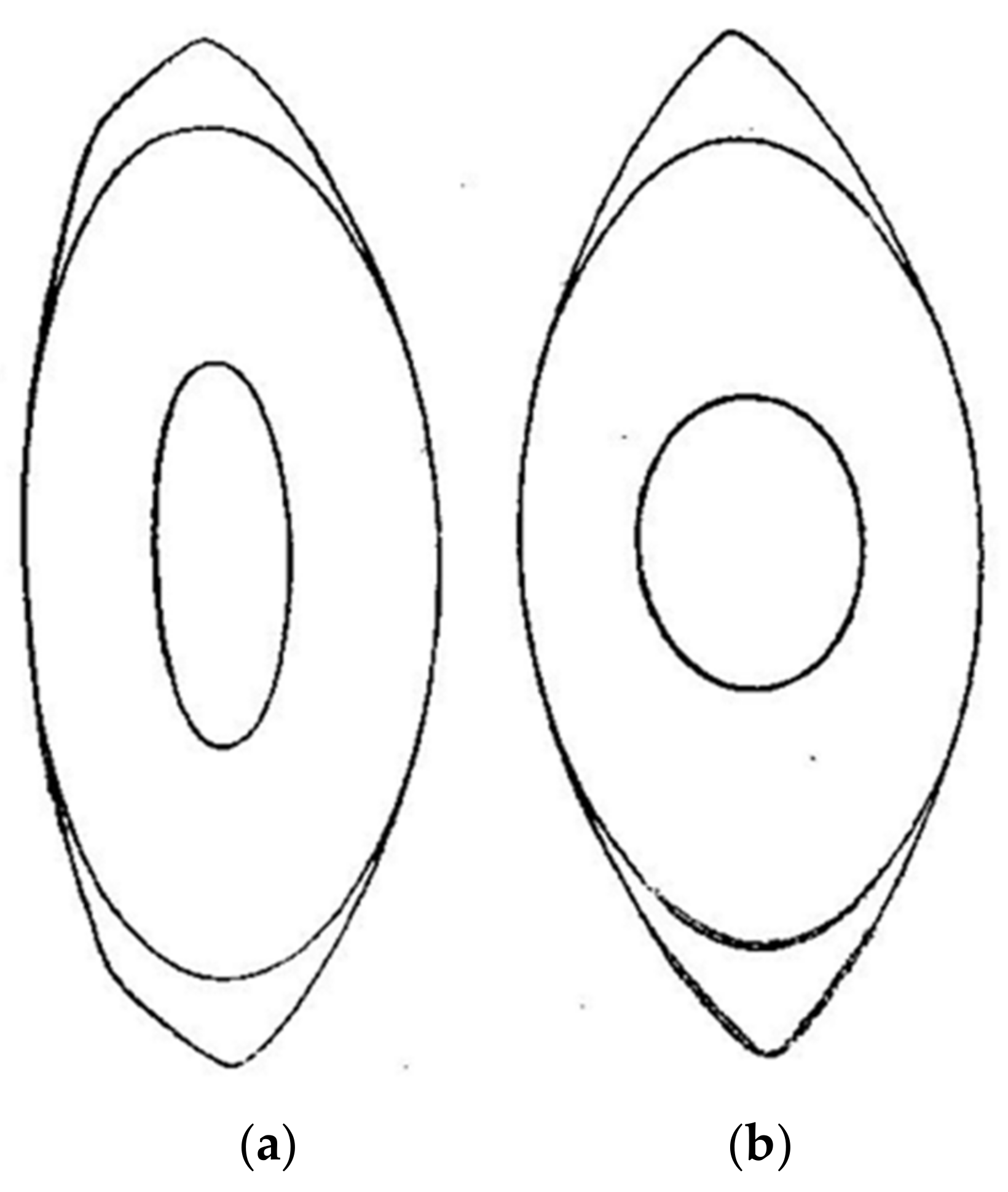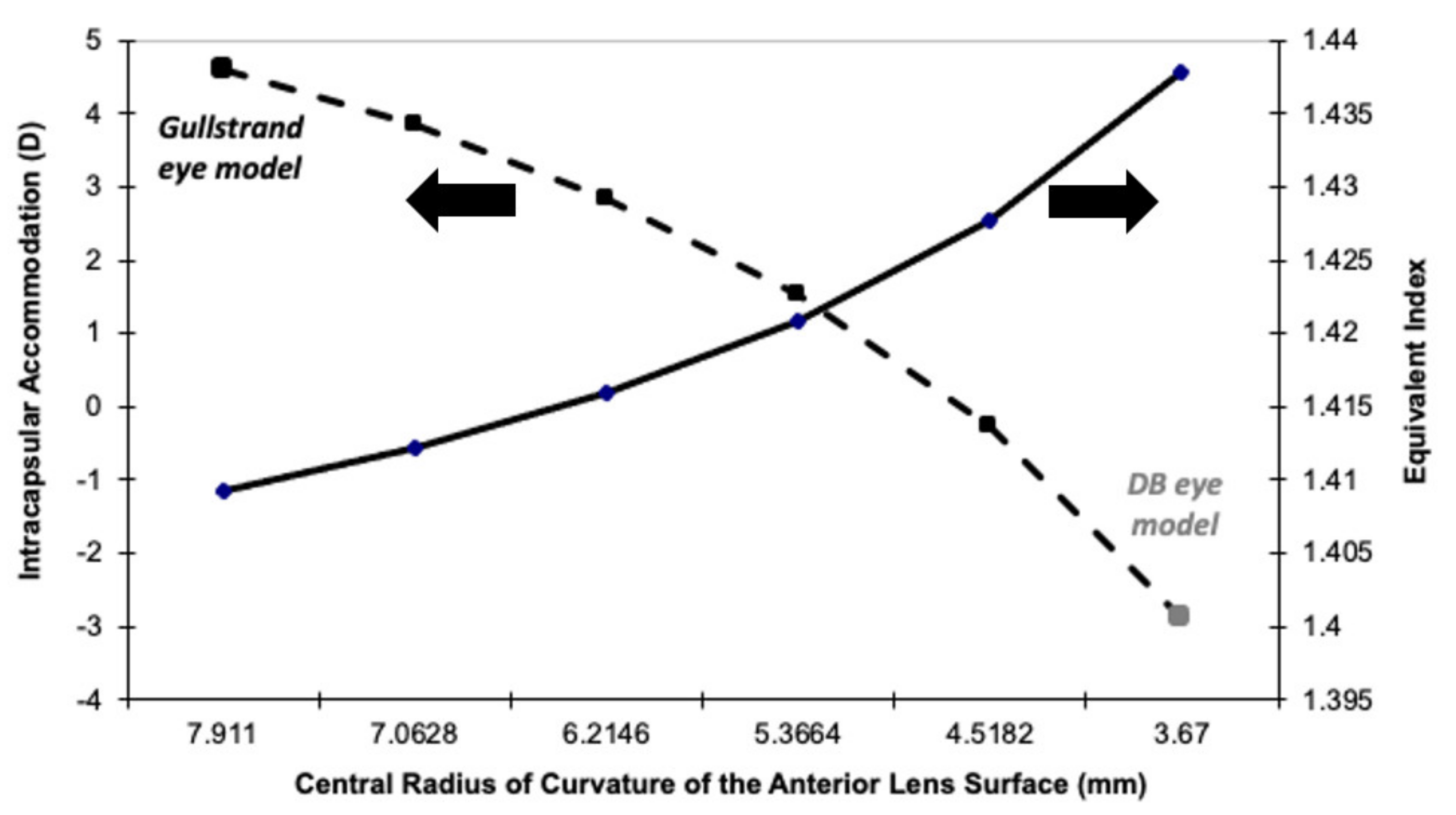Gullstrand Intracapsular Accommodation Mechanism Revised
Abstract
:1. Introduction
2. Materials and Methods
2.1. Eye Models
- Gullstrand eye model: The original model proposed by Gullstrand called “the exact schematic eye” in relaxed and accommodated (near point at 9.2 cm) states. The model details and measurements and Gullstrand’s calculations with this model can be found in his appendix to Helmholtz’s Physiological Optics [6].
- DB eye model: A two-element lens model based on four surfaces forming a nucleus and a cortex (similar to Gullstrand’s exact model eye), with values based on anatomical data of the cornea and the anterior and posterior radii of the lens by Dubbelman and collaborators [12,14,19], the change in the shape and the position of the lens during accommodation [20], as well as the change in the nucleus of the lens during accommodation [21]. In these studies [12,14,19], the subject fixated on a stimulus (usually a Maltese cross) which apparently approached the subject in steps of 1D by placing negative lenses in front of the subject’s eye. Scheimpflug imaging technology was used to obtain the topography of the cortex and nucleus surfaces of the lens during accommodation [19]. The lens refractive indices (cortex and nucleus) were obtained to match accommodation responses after objective measurements using aberrometry [14].
2.2. Paraxial Calculations
- The position of the image of an object formed at infinity through each of the six spherical surfaces of the relaxed model eye in Table 1 was found. This gave us the axial length of the emmetropic eye.
- The position of the object that forms an image on the retina of the accommodated eye was found. The vergence of that object corresponded to the paraxial accommodation of the eye.
- The equivalent refractive index (neq) of the relaxed emmetropic eye, using the same model eye as in step 1, but with a cortex and nucleus of the lens with the same index of refraction (neq), was calculated.
- The accommodation in the eye with a homogeneous lens (step 3) was calculated in a similar way to the heterogeneous lens (step 2), but this time only employing the lens surface changes and neq that was already calculated (step 3).
2.3. Non-Paraxial Calculations
2.4. Gradient of Curvature
3. Results
4. Discussion
Funding
Institutional Review Board Statement
Informed Consent Statement
Data Availability Statement
Acknowledgments
Conflicts of Interest
References
- Gullstrand, A. How I found the mechanism of intracapsular accommodation. Nobel Lect. Physiol. Med. 1901, 1921, 414. Available online: https://www.nobelprize.org/uploads/2018/06/gullstrand-lecture.pdf (accessed on 1 February 2022).
- Young, T. On the mechanism of the eye. Phil. Trans. 1801, 91, 23–88. [Google Scholar]
- Helmholtz, H. Ueber die accommodation des auges. Arch. Ophthalmol. 1855, 1, 1–89. [Google Scholar] [CrossRef]
- Smith, G.; Atchison, D. Equivalent power of the crystalline lens of the human eye: Comparison of methods of calculation. J. Opt. Soc. Am. A 1997, 14, 2537–2546. [Google Scholar] [CrossRef]
- Atchison, D.; Smith, G. Possible errors in determining axial length changes during accommodation with the IOLMaster. Opt. Vis. Sci. 2004, 81, 282–285. [Google Scholar] [CrossRef] [PubMed]
- Gullstrand, A. Mechanism of accommodation. In Handbuch der Physiologischen Optik (Helmholtz’s Treatise in Physiological Optics); von Helmholtz, H.H., Ed.; Southall, J.P.C., Translator; Optical Society of America: New York, NY, USA; Dover, UK, 1909; pp. 383–415. [Google Scholar]
- Le Grand, Y.; El Hage, S.G. Physiological Optics; Springer: Berlin, Germany, 1980; Volume 1. [Google Scholar]
- Koch, A.; Fischer, F.P. Über beobachtungen an der akkommofierten linse. Arch. Augenheilk. 1933, 107, 434. [Google Scholar]
- Fincham, E.F. The mechanism of accommodation. Br. J. Ophthal. 1937, 21 (Suppl. 8), 5–80. [Google Scholar]
- Huggert, A. The intracapsular mechanism of accommodation. Acta Ophthal. 1964, 42, 389–397. [Google Scholar] [CrossRef]
- Garner, L.F.; Smith, G. Changes in equivalent and gradient refractive index of the crystalline lens with accommodation. Vis. Sci. 1997, 74, 114–119. [Google Scholar] [CrossRef]
- Dubbelman, M.; Van der Heijde, G.L.; Weeber, H.A. Change in shape of the aging human crystalline lens with accommodation. Vis. Res. 2005, 45, 117–132. [Google Scholar] [CrossRef] [Green Version]
- Garner, L.F.; Yap, M.K. Changes in ocular dimensions and refraction with accommodation. Ophthalmic Physiol. Opt. 1997, 17, 12–17. [Google Scholar] [CrossRef] [PubMed]
- Hermans, E.A.; Dubbelman, M.; Van der Heidje, R.; Heethaar, R.M. Equivalent refractive index of the human lens upon accommodative response. Optom. Vis. Sci. 2008, 85, 1179–1184. [Google Scholar] [CrossRef]
- Smith, G.; Atchison, D.; Pierscionek, B.K. Modeling the power of the aging human eye. J. Opt. Soc. Am. A 1992, 9, 2111–2117. [Google Scholar] [CrossRef] [PubMed]
- Smith, G.; Pierscionek, B.K. The optical structure of the lens and its contribution to the refractive status of the eye. Ophthalmic Physiol. Opt. 1998, 18, 21–29. [Google Scholar] [CrossRef] [PubMed]
- Kasthurirangan, S.; Markwell, E.L.; Atchison, D.A.; Pope, J.M. In vivo study of changes in refractive index distribution in the human crystalline lens with age and accommodation. Investig. Ophthalmol. Vis. Sci. 2008, 49, 2531–2540. [Google Scholar] [CrossRef] [PubMed] [Green Version]
- Koretz, J.F.; Bertasso, A.M.; Neider, M.W.; True-Gabelt, B.A.; Kaufman, P.L. Slit-lamp studies of the rhesus monkey eye: II. Changes in crystalline lens shape, thickness and position during accommodation and aging. Exp. Eye Res. 1987, 45, 317. [Google Scholar] [CrossRef]
- Dubbelman, M.; Weeber, H.A.; Van der Heijde, G.L.; Volker-Dieben, H.J. Radius and asphericity of the posterior corneal surface determined by corrected Scheimpflug photography. Acta Ophthalmol. Scand. 2002, 80, 379–383. [Google Scholar] [CrossRef] [PubMed]
- Dubbelman, M.; Van der Heijde, G.L.; Weeber, H.A.; Vrensen, G.F.J.M. Changes in the internal structure of the human crystalline lens with age and accommodation. Vis. Res. 2003, 43, 2363–2375. [Google Scholar] [CrossRef] [Green Version]
- Hermans, E.A.; Dubbelman, M.; Van der Heijde, R.; Heethaar, R.M. The shape of the human lens nucleus with accommodation. J. Vis. 2007, 7, 16. [Google Scholar] [CrossRef] [Green Version]
- Bernal-Molina, P.; Vargas-Martín, F.; Thibos, L.N.; López-Gil, N. Influence of ametropia and its correction on measurement of accommodation. Investig. Ophthalmol. Vis. Sci. 2016, 57, 3010–3016. [Google Scholar] [CrossRef] [Green Version]
- Thibos, L.N.; Hong, X.; Bradley, A.; Applegate, R.A. Accuracy and precision of objective refraction from wavefront aberrations. J. Vis. 2004, 4, 329–351. [Google Scholar] [CrossRef] [Green Version]
- Navarro, R.; López-Gil, N. Impact of internal curvature gradient on the power and accommodation of the crystalline lens. Optica 2017, 4, 334–340. [Google Scholar] [CrossRef] [Green Version]
- Popiołek-Masajada, A.; Kasprzak, H. Model of the optical system of the human eye during accommodation. Ophthalmic Physiol. Opt. 2002, 22, 201–208. [Google Scholar] [CrossRef]
- Navarro, R.; Palos, F.; González, L.M. Adaptive model of the gradient index of the human lens. II. Optics of the accommodating aging lens. J. Opt. Soc. Am. A 2007, 24, 2911–2920. [Google Scholar] [CrossRef] [PubMed] [Green Version]
- Koretz, J.F.; Cook, C.A.; Kaufman, P.L. Aging of the human lens: Changes in lens shape upon accommodation and with accommodative loss. J. Opt. Soc. Am. A 2002, 19, 144–151. [Google Scholar] [CrossRef]
- Maceo, B.M.; Manns, F.; Borja, D.; Nankivil, D.; Uhlhorn, S.; Arrieta, E.; Ho, A.; Augusteyn, R.C.; Parel, J.M. Contribution of the crystalline lens gradient refractive index to the accommodation amplitude in non-human primates: In vitro studies. J. Vis. 2011, 30, 11–13. [Google Scholar] [CrossRef] [PubMed] [Green Version]
- Sheil, C.; Goncharov, A. Accommodating volume-constant age dependent optical (AVOCADO) model of the crystalline GRIN lens. Biomed. Opt. Express 2016, 7, 1985–1999. [Google Scholar] [CrossRef] [Green Version]
- Jones, C.; Atchison, D.; Meder, R.; Pope, J. Refractive index distribution and optical properties of the isolated human lens measured using magnetic resonance imaging (MRI). Vis. Res. 2005, 45, 2352–2366. [Google Scholar] [CrossRef]
- Dubbelman, M.; Van der Heijde, G.L. The shape of the aging human lens: Curvature, equivalent refractive index and the lens paradox. Vis. Res. 2001, 41, 1867–1877. [Google Scholar] [CrossRef]
- López-Gil, N.; Fernández-Sánchez, V. The change of spherical aberration during accommodation and its effect on the accommodation response. J. Vis. 2010, 10, 12. [Google Scholar] [CrossRef]
- Cheng, X.; Bradley, A.; Ravikumar, S.; Thibos, L.N. Visual impact of Zernike and Seidel forms of monochromatic aberrations. Optom. Vis. Sci. 2010, 87, 300–312. [Google Scholar] [CrossRef] [PubMed] [Green Version]
- López-Alcón, D.; Marín-Franch, I.; Fernández-Sánchez, V.; López-Gil, N. Optical factors influencing the amplitude of accommodation. Vis. Res. 2017, 141, 16–22. [Google Scholar] [CrossRef] [PubMed] [Green Version]
- Thibos, L.N.; Bradley, A.; López-Gil, N. Modelling the impact of spherical aberration on accommodation. Ophthalmic Physiol. Opt. 2013, 33, 482–496, Erratum in Ophthalmic Physiol. Opt. 2015, 35, 109. [Google Scholar] [CrossRef] [PubMed]



| Gullstrand Eye Model (6 Surf) Relax | Gullstrand Eye Model (6 Surf) Acc | DB Eye Model (6 Surf) | |
|---|---|---|---|
| Radius of the anterior surface of the cornea | 7.7 | 7.7 | 7.87 |
| Q of the anterior surface of the cornea | 0 | 0 | 0.85 |
| Corneal refractive index | 1.376 | 1.376 | 1.376 |
| Corneal thickness | 0.5 | 0.5 | 0.574 |
| Radius of the posterior surface of the cornea | 6.8 | 6.8 | 6.4 |
| Q of the posterior surface of the cornea | 0 | 0 | 0.82 |
| Refractive index of the aqueous humor | 1.336 | 1.336 | 1.336 |
| Anterior chamber depth | 3.1 | 2.7 | 2.996–0.036 D |
| Radius of the anterior surface of the lens | 10 | 5.333 | 1/(0.0894 + 0.0067 D) |
| Q of the anterior surface of the lens | 0 | 0 | −4.5–0.5 D |
| Refractive index of the cortex lens | 1.386 | 1.386 | 1.386 |
| Anterior cortex thickness | 0.546 | 0.6725 | 0.51 + 0.012 Age + 0.004 D |
| Radius of the anterior nucleus | 7.911 | 2.655 | 3.67–0.145 D |
| Q of the ant. and post. surf. of the nucleus | 0 | 0 | 0 |
| Refractive index of the nucleus | 1.406 | 1.406 | 1.406 |
| Nucleus thickness | 2.419 | 2.655 | 2.11 + 0.003 Age + 0.04 D |
| Radius of the posterior nucleus | −5.76 | −2.655 | −2.59 + 0.045 D |
| Posterior cortex thickness | 0.635 | 0.6725 | 0.33 + 0.0082 Age + 0.0006 D |
| Radius of the posterior surface of the lens | −6 | −5.333 | −1/(0.1712 + 0.0037 D) |
| Q of the posterior surface of the lens | 0 | 0 | −1.43 |
| Refractive index of the vitreous humor | 1.336 | 1.336 | 1.336 |
| Gullstrand Eye Model (6 Surf) Acc | Gullstrand Eye Model (4 Surf) Acc | DB Eye Model (6 Surf) Acc | DB Eye Model (4 Surf) Acc | |
|---|---|---|---|---|
| AA (paraxial) (D) Lens equivalent index | 10.9 | 6.31.409 | 7.9 | 8.2 1.439 |
| AA (no paraxial)(D) Lens equivalent index | 14.0 | 6.8 1.409 | 6.7 | 7.1 1.439 |
Publisher’s Note: MDPI stays neutral with regard to jurisdictional claims in published maps and institutional affiliations. |
© 2022 by the author. Licensee MDPI, Basel, Switzerland. This article is an open access article distributed under the terms and conditions of the Creative Commons Attribution (CC BY) license (https://creativecommons.org/licenses/by/4.0/).
Share and Cite
López-Gil, N. Gullstrand Intracapsular Accommodation Mechanism Revised. Photonics 2022, 9, 152. https://doi.org/10.3390/photonics9030152
López-Gil N. Gullstrand Intracapsular Accommodation Mechanism Revised. Photonics. 2022; 9(3):152. https://doi.org/10.3390/photonics9030152
Chicago/Turabian StyleLópez-Gil, Norberto. 2022. "Gullstrand Intracapsular Accommodation Mechanism Revised" Photonics 9, no. 3: 152. https://doi.org/10.3390/photonics9030152
APA StyleLópez-Gil, N. (2022). Gullstrand Intracapsular Accommodation Mechanism Revised. Photonics, 9(3), 152. https://doi.org/10.3390/photonics9030152





